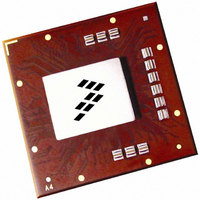MPC8560VT667LC Freescale Semiconductor, MPC8560VT667LC Datasheet - Page 18

MPC8560VT667LC
Manufacturer Part Number
MPC8560VT667LC
Description
IC MPU POWERQUICC III 783-FCPBGA
Manufacturer
Freescale Semiconductor
Datasheet
1.MPC8560VT667LC.pdf
(36 pages)
Specifications of MPC8560VT667LC
Processor Type
MPC85xx PowerQUICC III 32-Bit
Speed
667MHz
Voltage
1.2V
Mounting Type
Surface Mount
Package / Case
783-FCPBGA
For Use With
MPC8560ADS-BGA - BOARD APPLICATION DEV 8560
Lead Free Status / RoHS Status
Lead free / RoHS Compliant
Features
-
Available stocks
Company
Part Number
Manufacturer
Quantity
Price
Company:
Part Number:
MPC8560VT667LC
Manufacturer:
Freescale Semiconductor
Quantity:
10 000
Freescale Semiconductor, Inc.
Power Management
Power Management
The RapidIO unit on the MPC8560 supports the I/O and message-passing logical specifications, the
common transport specification, and the 8/16 LP-LVDS physical layer specification of the RapidIO
Interconnect Specification. It does not support the globally shared memory logical specification.
Highlights of the implementation include: support for four priority levels and ordering within a priority
level, CRC error management, 32- to 256-byte transactions and 8-bit data width ports.
The physical layer of the RapidIO unit can operate at up to 500 MHz. Because the interface is defined as a
source-synchronous, double-data-rate, LVDS-signaling interconnect, the theoretical unidirectional peak
bandwidth is 8 Gbps. Receive and transmit ports operate independently, resulting in an aggregate theoretical
bandwidth of 16 Gbps.
3.13.1 RapidIO Message Unit
The MPC8560’s RapidIO messaging supports one inbox/outbox structure for data and one doorbell
structure for messages. Both chaining and direct modes are provided for the outbox, and messages can hold
up to 16 packets of 256 bytes, or a total of 4 Kbytes.
3.14 Power Management
In addition to low-voltage operation and dynamic power management in its execution units, the MPC8560
supports four power consumption modes: full-on, doze, nap, and sleep. The three low-power modes: doze,
nap, and sleep, can be entered under software control in the e500 core or by external masters accessing a
configuration register.
Doze mode suspends execution of instructions in the e500 core. The core is left in a standby mode in which
cache snooping and time base interrupts are still enabled. Device logic external to the processor core is fully
functional in this mode.
Nap mode shuts down clocks to all the e500 functional units except the time base, which can be disabled
separately. No snooping is performed in nap mode, but the device logic external to the processor core is fully
functional.
Sleep mode shuts down not only the e500 core, but all of the MPC8560 I/O interfaces as well. Only the
interrupt controller and power management logic remain enabled so that the device can be awakened.
3.15 Clocking
The MPC8560 takes in the PCI_CLK/SYSCLK signal as an input to the device PLL and multiplies it by an
integer from 1 to 16 to generate the core complex bus clock (the platform clock), which operates at the same
frequency as the DDR DRAM data rate (for example, 266 or 333 MHz). The L2 cache also operates at this
frequency. The e500 core uses the CCB clock as an input to its PLL, which multiplies it again by 2, 2.5, 3,
or 3.5 to generate the core clock.
DLLs are used in the DDR SDRAM controller and the local bus memory controller (LBC) to generate
memory clocks. Six differential clock pairs are generated for DDR SDRAMs. Two clock outputs are
generated for the LBC.
The RapidIO transmit clock may be sourced from one of three locations: the platform clock, the RapidIO
receive clock, or a special differential clock input. This input is designed to receive inputs from an external
clock synthesis device driving a clock with a frequency of up to 500 MHz.
18
MPC8560 PowerQUICC III™
MOTOROLA
Integrated Communications Processor Product Brief
For More Information On This Product,
PRELIMINARY—SUBJECT TO CHANGE WITHOUT NOTICE
Go to: www.freescale.com











